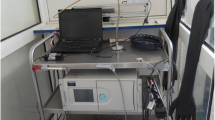Abstract
Objective : Exposures to respirable suspended particles (RSP) and environmental tobacco smoke (ETS) were assessed in Bremen, Germany, as part of a European air quality study. The range and level of personal exposures were assessed for housewives and office workers. Design : Nonsmokers were randomly selected from a representative sample of the population of Bremen. Housewives were recruited into one group primarily for assessment of exposures in the home and office workers, into a second group for assessment of the contribution of the workplace to overall exposure. Methods : A total of 190 subjects collected air samples from areas close to their breathing zone by wearing personal monitors for 24 h. Samples collected were analysed for RSP, ultraviolet-absorbing particulate matter (UVPM), fluorescing particulate matter (FPM), solanesol-related particulate matter (SolPM), nicotine and 3-ethenylpyridine (3-EP). Saliva cotinine levels for all subjects were also established. Results : Overall the levels found were quite low, with the majority of results being below the limit of quantification. Workers both living and working with smokers were exposed to the highest 24-h median quantities of RSP (789 μg) and ETS particles (128 μg) measured by FPM. The highest nicotine levels, based on median 24-h time-weighted average concentrations, were experienced by office workers working with smokers (0.69 μg m−3). These workers were also found to have␣the highest median cotinine levels (1.6 ng ml−1). Conclusions: The most highly exposed workers, both living and working with smokers, would potentially inhale over 20 cigarette equivalents (CE) per annum as based on the upper decile levels. Housewives living with smokers could inhale up to 11 CE per annum as based on the upper decile levels. Locations outside the workplace, including the home, contribute most to overall RSP and ETS particle exposure. Consideration should be given to extending the personal monitoring period in cities where levels appear to be quite low.
Similar content being viewed by others

Author information
Authors and Affiliations
Additional information
Received: 9 May 1997 / Accepted: 17 October 1997
Rights and permissions
About this article
Cite this article
Phillips, K., Howard, D., Bentley, M. et al. Measured exposures by personal monitoring for respirable suspended particles and environmental tobacco smoke of housewives and office workers resident in Bremen, Germany. Int Arch Occup Environ Health 71, 201–212 (1998). https://doi.org/10.1007/s004200050271
Issue Date:
DOI: https://doi.org/10.1007/s004200050271



